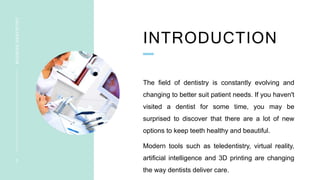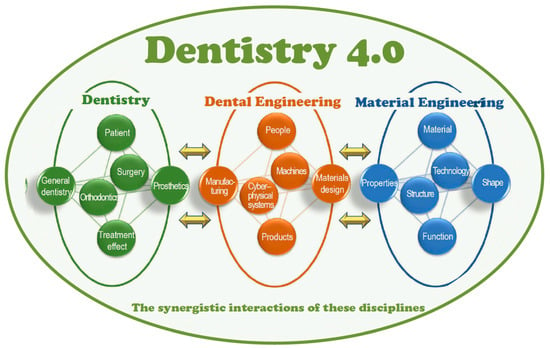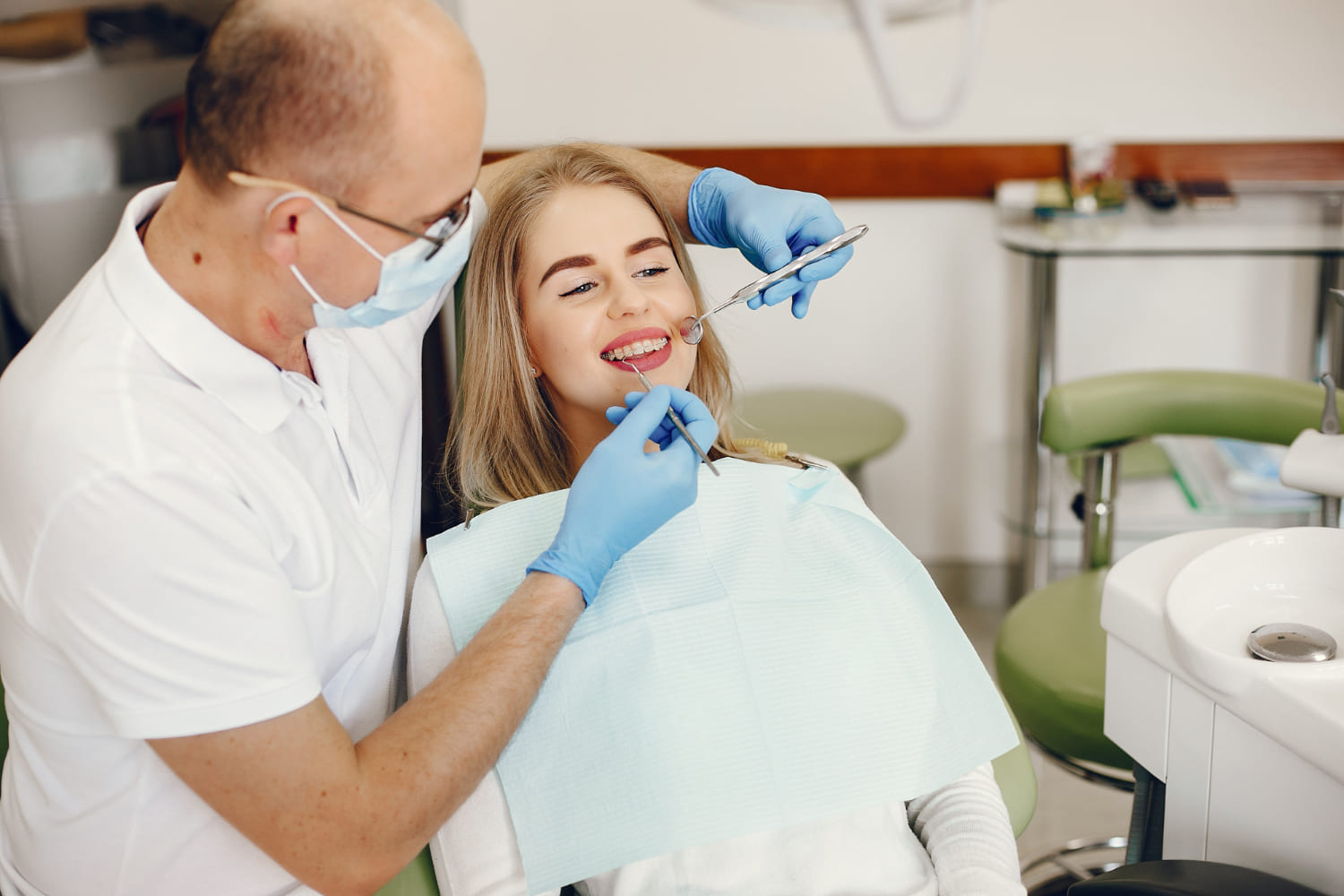Introduction to Modern Dentistry: Revolutionizing Oral Health Care
Dentistry has come a long way over the years, evolving from rudimentary and painful procedures to sophisticated, pain-free treatments that focus on improving both aesthetic appeal and functional health. Modern dentistry combines advanced technology, improved techniques, and patient-centered care to address a variety of dental concerns, from simple cleanings to complex procedures like dental implants and cosmetic enhancements.
In this article, we’ll explore the various facets of modern dentistry, its technological innovations, and how it has revolutionized oral health care for patients worldwide.

1. The Evolution of Modern Dentistry
A Brief History
The journey of dentistry dates back thousands of years, with the first recorded dental practices occurring in ancient Egypt and Mesopotamia. However, modern dentistry as we know it began taking shape in the 18th and 19th centuries, thanks to innovations by pioneers such as Pierre Fauchard, often referred to as the father of modern dentistry.
In the 20th century, the field underwent rapid advancement with the introduction of anesthesia, x-rays, and dental fillings, making treatments less painful and more accessible. Today, we benefit from high-tech solutions, such as laser dentistry, CAD/CAM technology, and robot-assisted surgeries, which have transformed how dental professionals approach both preventive and restorative care.
2. Key Innovations in Modern Dentistry
Digital X-rays and 3D Imaging
One of the most groundbreaking changes in modern dentistry has been the shift from traditional film-based x-rays to digital radiography. Digital x-rays produce clear, detailed images in seconds, which can be easily stored, shared, and analyzed. The benefits include:
- Lower radiation exposure
- Quicker diagnosis
- Enhanced accuracy in treatment planning
Alongside digital x-rays, 3D imaging has taken diagnostic capabilities to a whole new level. With the ability to capture detailed cross-sectional images of the mouth, 3D scans provide high-resolution views of teeth, bone structure, and surrounding tissues, enabling precise treatment planning.

Laser Dentistry
Lasers are now widely used in modern dental practices for a variety of procedures, from soft tissue treatments to cavity removal. Laser dentistry offers numerous advantages, including:
- Minimal discomfort and bleeding
- Faster recovery times
- Less need for anesthesia
Whether used for gum reshaping, tooth whitening, or decay removal, lasers provide a level of precision that is not possible with traditional methods, making the entire treatment experience more comfortable and efficient.
CEREC (Ceramic Reconstruction)
CEREC, or Chairside Economical Restoration of Esthetic Ceramics, is a modern technology that allows dentists to create custom ceramic crowns in a single visit. This CAD/CAM (computer-aided design and manufacturing) system eliminates the need for multiple appointments and temporary crowns, making it a convenient and cost-effective solution for patients in need of dental restorations.
Dental Implants
Dental implants have completely transformed the way we replace missing teeth. Unlike traditional dentures or bridges, implants are surgically placed into the jawbone, providing a stable, permanent foundation for crowns, bridges, or dentures. With advanced techniques and materials, dental implants offer numerous benefits, such as:
- Natural-looking results
- Improved functionality
- Long-term durability
They have become the gold standard for tooth replacement, providing a secure fit and better oral health compared to older alternatives.
3. Cosmetic Dentistry: A Focus on Aesthetics
In addition to improving oral health, modern dentistry has placed significant emphasis on cosmetic procedures aimed at enhancing the appearance of your smile. Whether it’s through whitening treatments, veneers, or orthodontic advancements, cosmetic dentistry has become a multi-billion dollar industry, thanks to its ability to boost self-confidence and enhance facial aesthetics.
Teeth Whitening
Teeth whitening is one of the most popular cosmetic dental procedures. Through various in-office or at-home treatments, patients can remove stains and brighten their smiles, often in as little as an hour. With advancements in whitening products, the process is now safer, more effective, and more accessible than ever before.
Porcelain Veneers
Porcelain veneers are thin shells of ceramic material that cover the front surface of the teeth. They are ideal for correcting a variety of cosmetic imperfections, including:
- Discoloration
- Chipped or cracked teeth
- Misalignment
These durable, natural-looking veneers are custom-made to fit each patient’s smile, giving them a radiant, uniform appearance.
Invisalign and Clear Braces
For those seeking a discreet orthodontic treatment option, Invisalign and other clear aligners offer a revolutionary solution to straighten teeth without the visibility of traditional braces. Using a series of custom-made aligners, patients can achieve a beautiful smile with minimal discomfort and hassle.
4. Preventive Dentistry: The Key to Long-Term Oral Health
Modern dentistry emphasizes prevention as the key to maintaining long-term oral health. Routine dental check-ups, cleanings, and early detection of potential issues are essential in preventing more severe dental problems down the road.
The Importance of Regular Check-Ups
Preventive dentistry includes regular visits to the dentist, usually every 6 months, for cleanings, examinations, and x-rays. During these appointments, dental professionals can:
- Detect early signs of tooth decay
- Identify gum disease
- Provide fluoride treatments
By catching problems early, dentists can often avoid the need for more invasive treatments, saving time, money, and discomfort for patients.
Sealants and Fluoride Treatments
For children and adults alike, dental sealants can help protect teeth from cavities, especially in hard-to-reach areas like the back molars. Fluoride treatments further strengthen tooth enamel, making teeth more resistant to decay. Both of these preventive measures are important components of modern dental care.
5. The Future of Dentistry
As technology continues to evolve, the future of dentistry looks incredibly promising. We can expect even more innovations that will make dental procedures faster, more comfortable, and minimally invasive. Here are a few exciting trends to watch out for:
- Regenerative dentistry: The potential for regenerating damaged teeth and gums using stem cells or other biological materials could dramatically reduce the need for implants or bridges.
- Artificial Intelligence (AI): AI can help dentists with diagnostics, treatment planning, and even patient education, enhancing the overall care process.
- 3D Printing: This technology has the potential to revolutionize dental implants, crowns, and bridges by allowing for precise, on-demand production.
FAQ: Frequently Asked Questions
Q1: How does laser dentistry work?
A1: Laser dentistry uses focused light beams to treat a variety of dental conditions with minimal discomfort and faster healing. It’s commonly used for soft tissue procedures, cavity removal, and teeth whitening.
Q2: Are dental implants permanent?
A2: Yes, dental implants are designed to be permanent. With proper care and maintenance, they can last a lifetime, offering a more stable and durable solution compared to dentures or bridges.
Q3: Is Invisalign really effective?
A3: Yes, Invisalign is a highly effective treatment option for straightening teeth. It works just as well as traditional braces for many people but offers the added benefit of being virtually invisible and more comfortable.
Q4: How often should I visit the dentist?
A4: It’s recommended to visit the dentist at least twice a year for check-ups and cleanings. However, your dentist may recommend more frequent visits depending on your oral health.
Conclusion
Modern dentistry is a dynamic and ever-evolving field that has completely transformed the way we approach oral health care. From cutting-edge technologies like digital x-rays and lasers to innovative cosmetic treatments and preventive care, today’s dental practices offer an unprecedented level of care and convenience. Whether you’re looking to maintain a healthy smile, restore missing teeth, or enhance your facial aesthetics, modern dentistry provides solutions that can address your needs with precision and efficiency.
As we continue to explore new advancements, it’s clear that the future of dentistry will bring even more innovative treatments that make dental procedures quicker, safer, and more accessible. Investing in your oral health through modern dental care is not just a commitment to your smile, but to your overall well-being.

